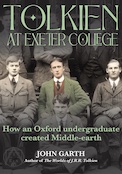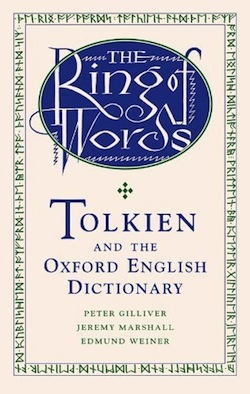John Garth
The Ring of Words: Tolkien and the Oxford English Dictionary
Peter Gilliver, Jeremy Marshall and Edmund Weiner
OUP 2006; paperback 2009; Kindle
© John Garth. Reproduced from the Times Literary Supplement, 23 June 2006, with permission, and slightly updated.
When J.R.R. Tolkien, veteran of the Somme, met up with Old Boys from school at Oxford during 1919, he imparted a vivid impression of life in the front line — not of war, but of words. ‘Rumours of a dictionary beside which all previous dictionaries shall be as vocabularies reach us,’ one alumnus wrote to the school newspaper, ‘and we go on our way shivering.’
The Oxford English Dictionary, for which Tolkien worked as an assistant lexicographer from Armistice until 1920, had been accreting in portions at a stately pace since 1884; full publication was still nine years away. Critics now display a similar nervous aversion to The Lord of the Rings, The Silmarillion, and especially the twelve-volume History of Middle-earth in which the seven-decade crafting of the ‘legendarium’ is examined by Tolkien’s son Christopher.
Yet this timorous reaction is more than an amusing coincidence: as The Ring of Words demonstrates, J.R.R. Tolkien’s mode of creativity is the close artistic equivalent to the philosophy and technique behind the OED, and the range, detail, depth and scale of his imaginative enterprise follows inevitably.
Gilliver, Marshall and Weiner, all of them current OED editors, give an equally vivid impression of life in the front line of words. They show how Tolkien explored the etymology of such words as walrus, waggle and wariangle, locating cognates in other languages and, through a process akin to triangulation, reconstructing the earlier, unrecorded antecedents. Tolkien’s writing method was analogous: he would observe traces of now-forgotten mythological stories in the Christianised Germanic literatures and attempt to reconstruct the full lost tales. Thus, Anglo-Saxon, Norse and German fragments contain the cognates Éarendel, Örvandill, Orendel, denoting a star or a mariner; accordingly, Tolkien made Eärendil a seafarer who sails over earth’s edge to become the Evening Star.
But the etymological analogy, previously explored by Tom Shippey in The Road to Middle-earth, is not the only salient parallel between Tolkien’s creative method and the OED. According to the three authors of The Ring of Words, ‘In describing his own creative processes, Tolkien often comments on how the contemplation of an individual word can be the starting point for an adventure in imagination — and contemplating individual words is precisely what lexicographers do. As workers on the same great project, we find ourselves in the unusual position of looking at language from very much the same perspective.’ It is in the nature of philology to explore every avenue of human knowledge, and the same spirit impelled Tolkien to invent everything from star mariners to calendars, flowers, cities, foodstuffs, writing systems and birthday customs, to mention just a few of the eclectic features of Middle-earth.
| “The Ring of Words successfully reunites the academic and creative aspects of Tolkien, often seen as at odds (particularly by fellow academics who felt he had squandered his talent on childish stories)” |
This close match between Tolkien’s creative processes and his professional, philological approach also makes The Ring of Words a valuable contribution to study of the OED itself. In focusing on an individual assistant’s work, it complements others that take a broader view, such as Simon Winchester’s The Meaning of Everything.
An account of Tolkien’s work in the ‘great dusty workshop’ of the OED offices ably explains the stages of composition and revision that produce OED entries; the chief novelty is the glimpse of Tolkien as a tyro struggling with house style, his more exploratory etymologies cut back by Henry Bradley like so much convolvulus. An examination of how Tolkien used English words in his creative writings makes a vital contribution by locating him as the latest and best ambassador of archaic revivalism, after Walter Scott, George Dasent and William Morris. An alphabetical pot-pourri follows: discussions of specific words that Tolkien revived (such as oliphaunt or mathom), used distinctively (elf, lockholes), coined from English matter (staggerment, smial), or wrongly thought he had coined (hobbit and, as it now emerges, orc); among many insights it is a pleasure to realise that the names of the two hobbits who find the Ring, Déagol and the Cain-like Sméagol, mean respectively ‘secretive’ and ‘inquisitive’. The book is rounded off with a brief, provisional comment on Tolkien’s on-going impact on the language.
The authors have filleted their subject of some less digestible portions, a decision which might be welcomed by those who shiver at the thought of multi-volume dictionaries or fantasies, but which seems a trifle unfortunate in a book that deals with both. It would have been illuminating to hear just how Tolkien established the cognates and antecedents for his OED etymologies, but an adequate explanation of the principal methods of comparative philology is missing.
However, The Ring of Words successfully reunites the academic and creative aspects of Tolkien, often seen as at odds (particularly by fellow academics who felt he had squandered his talent on childish stories). His academic publications, though sparse, were enduring: his chief solo contribution to lexicography, A Middle English Vocabulary, is here shown to be a monument of erudition and sheer sweat.
The Ring of Words also evidences Tolkien’s secondary contribution to the study of English: the inspiration he provided while alive to students such as Robert Burchfield, who became editor of the four-volume OED supplement, and posthumously to enthusiasts of The Lord of the Rings such as Gilliver, Marshall and Weiner. Increasingly, Tolkien’s influence begins with his creative writings, but that is only fitting: as this book demonstrates, Middle-earth celebrates what language meant to Tolkien, an expert excavator and unique practitioner in the field.
See also:
OED 4.0 CD-rom, reviewed by John Garth
The Worlds of
J.R.R. Tolkien
UK hardback
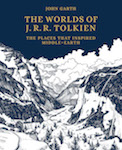
US hardback

To buy in French, Russian, Czech, Spanish, Italian, Finnish, Hungarian, German, or another language
see links here
Buy
Tolkien and
the Great War
UK paperback/ebook
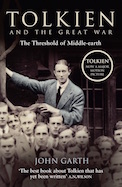
US paperback/ebook
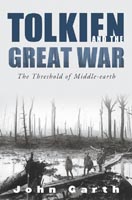
Audiobook read by
John Garth
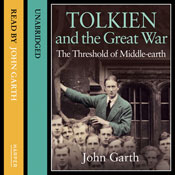
Amazon UK, Audible UK,
Audible US
To buy in Italian, German, French, Spanish or Polish,
see links here
Buy
Tolkien at
Exeter College
